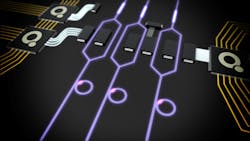Quantum startups in Germany are embracing several different technology platforms, including atoms, ions, superconducting qubits, or photons, to exploit quantum phenomena in real-world applications.
Quantum Optics Jena (QOJ), Q.ANT, and KEEQuant are among those focusing on photonic solutions within the fields of computing and communications, as well as for other applications such as sensing.
These startups “use the special properties of photons with the advantage that the quantum information photons carry is only slightly disturbed by the environment,” says Andreas Tünnermann, a professor and the director of the Institute of Applied Physics at Friedrich-Shiller University of Jena and the Fraunhofer Institute of Applied Optics and Precision Engineering (IOF). “These companies emerged from various working groups at universities or institutes that worked within the quantum optics field for many years.”
PhoQuant research project
A consortium of 14 German companies and academia, led by Q.ANT, recently received 45 million Euros in funding from the German Federal Ministry of Education and Research for the PhoQuant research project to build a demonstration and test facility for quantum computer chips and other quantum computing components. Its partners are contributing another 8 million Euros.
Q.ANT, which is a wholly owned subsidiary of TRUMPF, developed a process to create quantum computer chips by depositing highly specialized light channels onto silicon wafers (see figure). This allows quanta to be guided, controlled, and monitored in photonic integrated circuits (PICs)—even at room temperature.
It’s a “quantum leap” forward because current quantum chips must be cooled to almost absolute zero (-273°C), which means they’re unusable for direct on-chip coupling with classical computer architectures.
As part of this consortium, Friedrich-Schiller University of Jena and IOF researchers are developing integrated optical quantum light sources and low-loss integrated optical and fiber-optic interferometers as elementary building blocks of photonic quantum computers.
The Fraunhofer Society is, not surprisingly, playing a key role in the transfer of basic quantum research to real-world applications. “With expertise in microelectronics, nanotechnology, and photonics, Fraunhofer Institutes are supporting many startups developing the first demonstrators,” Tünnermann says.
IOF in Jena is a partner of many research groups and startups working on optomechanical systems to address and read quantum states. “We’re also involved in the development of photonic integrated circuits that implement the basic functionalities of quantum computers and quantum communication systems,” he adds.
Since the 1990s, IOF has worked within the field of design and development of integrated optical circuits. “For photonic integrated circuits, optical functions such as splitting signals, delaying signals or their amplitude and phase modulation with simultaneous polarization control, must be integrated into one optical device,” says Tünnermann.
To achieve this, “we use high-end electron beam lithography to manufacture chips in a wide variety of material systems such as silicon nitride, lithium niobate, sodium titanate, and monocrystalline diamond—each of these material systems address specific needs of our partners in science and industry,” he adds. “In general, the greatest challenge is to control and minimize optical losses, especially when connecting the components with fiber networks. Our many years of experience help us today to address the special requirements in quantum technologies.”
Bringing nonclassical light generation on-chip
One of the biggest challenges to date is that many quantum groups worldwide started out working on hybrid systems—in which light generation and manipulation are spatially separated and not integrated on a chip—to demonstrate quantum computing based on a photonic platform.
“For future quantum computer and communication chips, we need to integrate the generation of nonclassical light,” he says. “This is currently one of our greatest technological challenges.”
Tünnermann helped shape the first quantum revolution, and is enthusiastic about working on the next one. “From our work on the development of high-performance lasers and their application within a wide variety of markets, a new branch emerged: the photonics industry,” he says.
He views current quantum developments as comparable to that of laser technology during the last century. “Once again, I have the opportunity to support the development of a new industry to provide solutions to overcome the great challenges facing humanity,” says Tünnermann. “It’s important to get young people interested and to promote the founding of companies.”
About the Author
Sally Cole Johnson
Editor in Chief
Sally Cole Johnson, Laser Focus World’s editor in chief, is a science and technology journalist who specializes in physics and semiconductors.

